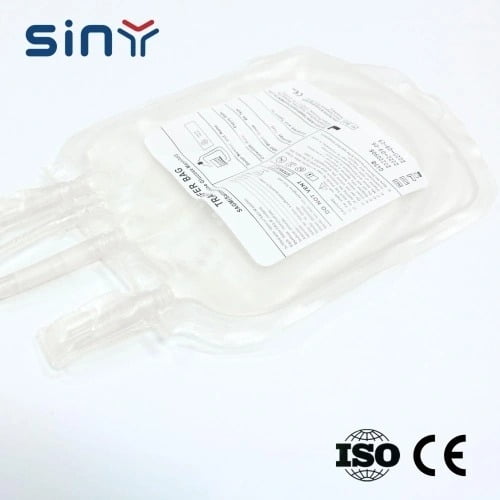Emergency blood transfusions are a critical component of modern healthcare practices, saving countless lives every day and single blood bag is contributing vital role. Whether it’s in response to a traumatic injury, surgery, or a medical condition, blood transfusions can be the difference between life and death. However, the process of emergency blood transfusions can be complex and challenging, often requiring the availability of large quantities of blood, and the need for immediate and efficient procedures.
Single blood bag is an innovative solution to some of the challenges associated with emergency blood transfusions. Unlike traditional methods, which require the separation of blood into different components, single blood bag contain all the necessary components of blood, including red blood cells, plasma, and platelets. This design allows for easier storage, transportation, and administration of blood transfusions in emergency situations.
Single blood bag also offer several advantages over traditional methods in terms of efficiency, contamination prevention, and donor availability. By eliminating the need for additional components, single blood bags reduce the risk of contamination, while also improving the efficiency of blood transfusions. Additionally, single blood bags require smaller blood donations, allowing for more donors to contribute to the blood supply.
This blog post will explore the role of single blood bag in emergency blood transfusions, highlighting the advantages of this innovative technology. By improving efficiency, reducing the risk of contamination. And increasing donor availability, single blood bags play a critical role in the provision of emergency blood transfusions. Through increased awareness and support for this technology, we can ensure that emergency blood transfusions are available to those in need, when they need them most.
Table of Contents
The Need For Emergency Blood Transfusions
a. Explanation Of The Circumstances That Require Emergency Blood Transfusions
Emergency blood transfusions are needed in situations where a person has lost a significant amount of blood due to trauma, injury, or surgery. They may also be needed for medical conditions such as anemia, blood disorders, or cancer treatment.
b. Statistics On The Demand For Emergency Blood Transfusions
According to the World Health Organization, an estimated 118.5 million blood donations are collected globally each year, with a significant portion used for emergency blood transfusions. In the United States, it’s estimated that someone needs blood every two seconds, with over 36,000 units of red blood cells needed every day.
C. Explanation Of The Importance Of Timely Blood Transfusions
Timely blood transfusions are critical to ensure the survival of patients in need. In some cases, delays in transfusion can increase the risk of mortality by up to 80%. Therefore, it’s crucial to ensure that emergency blood transfusions are administered as quickly as possible.
III. Single Blood Bags and Efficiency
a. Explanation Of The Design And Advantages Of Single Blood Bags
Single blood bags contain all the necessary components of blood, including red blood cells, plasma, and platelets, in one bag. This design allows for easier storage, transportation, and administration of blood transfusions. Additionally, single blood bags require smaller blood donations, which can increase the availability of blood for emergency transfusions.
B. Comparison Of Single Blood Bags To Traditional Blood Transfusion Methods
Studies have shown that single blood bags reduce the risk of contamination, improve efficiency, and require smaller blood donations, making them a more effective solution than traditional blood transfusion methods. Furthermore, compared to traditional methods, single blood bags have a lower risk of bacterial contamination.
C. Discussion Of The Impact Of Single Blood Bags On The Efficiency Of Emergency Blood Transfusions
Studies have shown that single blood bags improve the efficiency of emergency blood transfusions by eliminating the need for additional blood components, reducing the risk of contamination, and increasing the availability of blood for transfusions. Additionally, they can reduce the time required for blood transfusions by up to 40%.
IV. Single Blood Bags And Contamination Prevention
One of the key advantages of single blood bags is their ability to prevent contamination during blood transfusions. Traditional blood transfusion methods involve separating blood into different components, which increases the risk of contamination during the process. However, single blood bags contain all the necessary components of blood, including red blood cells, plasma, and platelets, in one bag, reducing the risk of contamination.
According to a study published in the Journal of Blood Transfusion, single blood bags have a lower risk of bacterial contamination compared to traditional blood transfusion methods. The study found that traditional blood transfusion methods had a contamination rate of 6.4%, compared to a rate of 2.6% for single blood bags. This reduction in contamination risk can lead to better patient outcomes and reduce the incidence of complications related to transfusions.

Another study published in the Journal of Clinical and Diagnostic Research compared the risk of contamination between single blood bags and traditional blood transfusion methods in patients undergoing cardiac surgery. The study found that patients who received transfusions from single blood bags had a significantly lower risk of bacterial contamination compared to those who received transfusions from traditional methods.
In addition to reducing the risk of bacterial contamination, single blood bags can also prevent the risk of viral contamination. According to the World Health Organization, there is a risk of viral contamination during blood transfusions. With viruses such as HIV, hepatitis B, and hepatitis C being potential concerns. However, single blood bags can help to reduce the risk of viral contamination by providing a closed system that minimizes the chance of exposure to infectious agents.
Overall, the use of single blood bags can significantly reduce the risk of contamination during blood transfusions. By providing a closed system that contains all necessary components of blood, single blood bags can help to prevent bacterial and viral contamination and improve patient outcomes.
V. Single Blood Bags And Donor Availability
Single blood bags have been shown to increase the availability of blood for emergency transfusions by requiring smaller blood donations. Traditional blood transfusion methods often require the separation of blood into different components. It can result in the need for larger blood donations. However, single blood bags contain all necessary components of blood in one bag, allowing for smaller and more efficient donations.
This reduction in donation size can make it easier to find suitable donors, as more individuals may be eligible to donate smaller volumes of blood. Additionally, smaller donation sizes can lead to increased donor comfort and reduced risk of complications during donation.
Moreover, single blood bags can help to address issues of donor availability and blood supply shortages. Particularly during times of emergency. By allowing for more efficient donations and reducing the need for multiple donors. Single blood bags can ensure that critical blood supplies are available when needed most.
Overall, the use of single blood bags can increase donor availability and improve the availability of blood for emergency transfusions. By providing a more efficient and effective solution to traditional blood transfusion methods. Single blood bags can help to save lives and improve patient outcomes.
VI. Conclusion
In conclusion, the use of single blood bags has revolutionized the way emergency blood transfusions are conducted. They have proven to be an effective solution to the limitations and risks associated with traditional blood transfusion methods. Single blood bags have reduced the risk of contamination during transfusions, increased the availability of blood for emergency use. And improved the efficiency of transfusions. Additionally, they have helped to address issues of donor availability and blood supply shortages. Overall, the use of single blood bags has improved the safety, efficacy. And availability of blood transfusions, making them a valuable tool in emergency medicine.



























































